-
Car Reviews
- Car News
-
Car Comparisons
Latest comparisons
- Chasing Deals
We’re having a blast in the Chasing Cars garage this week, because we’re taking a deep dive into the Mazda MX-5 – the car that took the recipe from the British MG roadsters of the 1960s, and added reliability and affordability to the mix. More than a million MX-5s have come down the production line since 1989, making it the most successful roadster ever. But while a soft-top MX-5 may be the archetypal form of this car, for this ND generation Mazda have created a new body style, dubbed the retractable fastback, or RF. In reality, it’s a targa roofed, hardtop MX-5. So while Tom spent the week in the entry-level 1.5-litre roadster, I’ve been driving the opposite end of the lineup, the 2017 Mazda MX-5 RF 2.0 GT, to find whether the hardtop bodystyle, and the larger 2.0-litre engine it is exclusively available with, add – or subtract – from any of the magic of this Mazda roadster.
The RF bodystyle is a huge talking point about the latest generation of MX-5, as Mazda has until now only made the MX-5 available as a classic soft-top roadster, or a conventional hardtop. The previous NC generation was available with a folding hardtop, called Roadster Coupe – a variant that eventually outsold the roadster so well in Australia that Mazda cut the soft-top out of the range. Mazda aren’t expecting to ditch the ND soft-top anytime soon, but they did predict at the RF’s launch that the hard-top would, once again, become the most popular choice. That has borne out: less than six months into the RF’s lifespan it is already accounting for 60% of the MX-5’s monthly Australian sales of around 140 units.
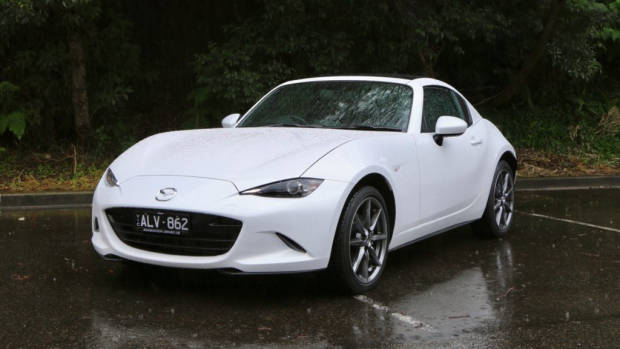
Unlike the NC’s metal hardtop, which essentially mirrored the cloth soft-top and was able to fold entirely away, merely the RF’s top roof section disappears when the roof is retracted. The result is an intriguing design marked by twin flying buttresses. In our experience, some loved this, and some hated it. To my eyes, the RF looks great from some angles and less successful from others. However, the main point is that with the RF, the hardtop MX-5 is now its own, unique idea – it’s no longer simply a soft-top converted to metal.
Buying an RF does mean sacrificing the roadster’s ingeniously simple soft roof that the driver can manually fold away – on the fly – in a couple of seconds. However, the RF introduces a beautiful folding mechanism, where the rear section of the roof lifts up, the roof panel and rear window raise or lower before the buttresses land again. The process takes a brief 12 seconds – frustratingly, though, it’s only possible at up to 10km/h.
I have experienced three forms of the ND MX-5: the RF we’re driving here; my own two-litre soft-top; and the 1.5-litre soft-top Tom drove. The basic car certainly feels the most light and dainty of the trio – all 1.5-litre MX-5s have thinner tyres than the two-litre version: 195 R16s, versus 205 R17s. That means you find the upper limit of grip in the 1.5-litre more quickly than in the stickier 2.0-litre. The larger wheels of the 2.0-litre cars give the MX-5 a firmer ride quality, and they certainly add more firmness and feel to the steering, though the steering rack isn’t as pleasant as older generations of the MX-5.
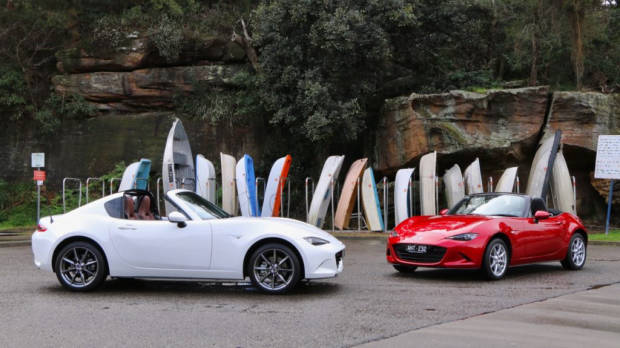
The MX-5’s driving position, which resembles rowing, legs stretched right out in front of you, isn’t spec-dependent – and the GT still makes do with annoying tilt-only steering wheel adjustment. The GT spec doesn’t change the fundamentals of the MX-5 cabin – the seats are somewhat supportive and comfortable over long journeys, but I wish the Recaros from overseas were available in Australia. The major controls are ergonomic and close to the driver, and the steering wheel is lovely to hold. No MX-5 gets a digital speedometer, which is annoying, considering that the angle of the speedo can make it hard for taller drivers to judge their speed – a worrying thing in speed camera-obsessed Australia.
Here in Australia, the RF is only available with the more powerful 2.0-litre. Like in the roadster, it produces 118kW of power and 200Nm of torque, and will sprint from 0-100km/h in just over seven seconds. The 2.0-litre has about 25% more power than the 1.5-litre and a third more torque – and as you’d expect, it feels substantially stronger. That generous torque arrives earlier, too, so the 2.0-litre can be driven in higher gears – fifth gear is driveable at 60km/h. We found the 2.0-litre to be slightly more economical, returning 6.8L/100km over a combined test compared to 7.2L/100km in the lighter but less powerful 1.5-litre roadster.
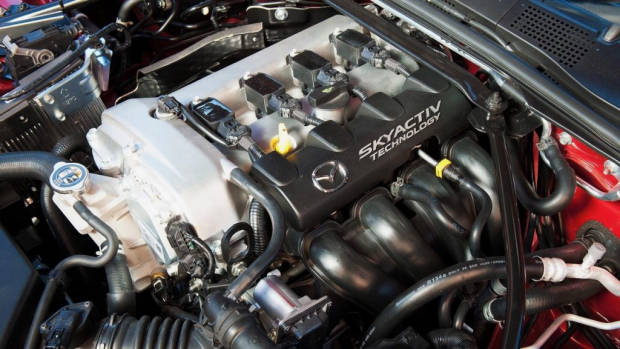
But while the 2.0-litre is faster, it is not a particularly sweet engine, sounding coarse and uninteresting at high revs – especially compared with the darling 1.5-litre which is immensely sweet-sounding, and free-revving.
The metal roof adds an extra element of security to the RF, and makes the driving experience slightly quieter with the roof up. One of the best features of the cloth soft-top is that when the roof is down, the aerodynamics are so good that wind and noise are surprisingly minimal in the cabin. In the RF – with its protruding fastback structure – things aren’t quite as refined. Drop the targa and both wind and wind noise enter the cabin. That’s something of a surprise, given the positioning of the $5,000-dearer RF as the more refined and luxurious MX-5 choice.
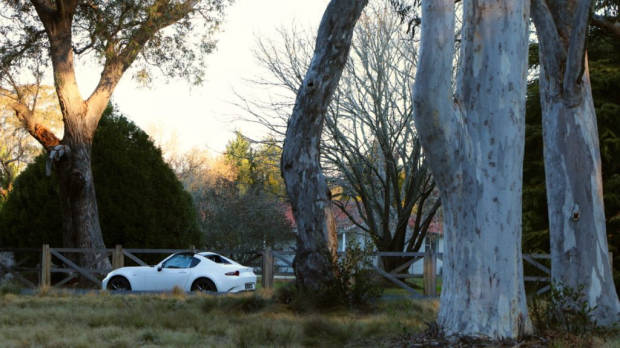
The RF GT I drove sits at the top of the Australian MX-5 range, and is priced at $43,890 – $10,500 more than the base 1.5-litre roadster Tom drove, and $4,000 more than the equivalent 2.0-litre GT soft-top. Like other MX-5s, there are a couple of particularly special paints – Soul Red, and the RF-only Machine Grey – that command a $300 premium, while an additional $1,000 can kit an RF with a unique black roof outside, and auburn-brown nappa leather inside.
That $43,890 buys a well-equipped little car, however. Grey 17-inch wheels, climate control, heated leather seats, automatic cornering LED headlights, a seven-inch touchscreen with navigation, a 203-watt nine-speaker Bose stereo and tyre pressure monitoring are all included. Blind spot monitoring and rear cross-traffic alert make manoeuvring easier. Manual models are also fitted with a limited slip differential at no additional cost.
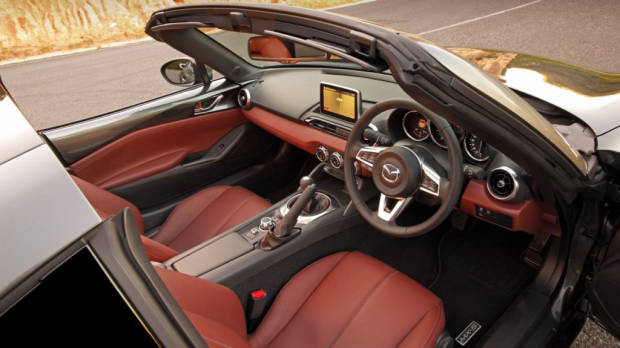
While we commend Mazda for adding blind spot and rear cross-traffic sensing to the MX-5’s standard fare in 2016, it’s disappointing that a reversing camera remains an optional accessory, priced at $500. Experience from my own car – a 2016 MX-5 2.0 GT, as it happens – tells me that it is a massive help when parking, especially in bad weather with the roof up. Buyers shouldn’t have to pay extra for a tool everybody expects in 2017. Sure, the MX-5 is a small car – but it has poor rearward visibility. It’s a letdown when all Toyota 86s – a key rival – fit a reversing camera as standard.
Inside, the MX-5 GT is more luxurious than the entry-level grade, with quality leather on the seats and door inserts. The GT’s nine-speaker Bose sound system is punchy, with good aural quality at all volumes – something helped by having to speakers in each headrest, just like the first generation NA MX-5. The GT’s door tops are body coloured, which works with some colours and doesn’t with others. The Crystal White Pearl body colour and brown nappa leather of our test car wasn’t met with praise.
The RF’s good-looking buttressed roof does reduce visibility, becoming an impediment while reversing. Seeing out the rear is difficult – and the lack of a standard reversing camera, almost forgivable on the soft-top, seems very short-sighted on the RF.

It isn’t all impractical, though. The RF’s roof design cleverly avoids eating into boot space. Like the roadster, the mechanism is isolated into a void between the seatbacks and the boot cavity – meaning the 127 litres (3 litres less than the roadster) is fixed, even when the roof is down. 127 litres isn’t much but it is adequate space for a couple of soft weekend bags.
Plus, Mazda fit a storage tray to the boot of the RF to hold basic tools and the owner’s manual – helpful, given cabin storage is at an absolute minimum. The more complicated RF mechanism does mean the central stowage box behind the front seats is smaller. The roadster also features hidden storage boxes behind each individual seat – one of those disappears on the RF. While the removable cupholders and small tray between the seats carry over from the soft-top, the reality is, of course, that the MX-5 is never going to be a practical choice.
So now that the MX-5 has two distinct bodystyles, is there any difference in how they drive? The RF’s weight penalty over the entry 1.5-litre roadster is up to 97kg – or about ten per cent – but the RF is still a light car. Even the heaviest version, with the automatic gearbox, weighs just 1,109kg. The RF’s weight gain is attributable to the metal roof – and its consequences, which includes work done to strengthen and stiffen the chassis to reduce additional body roll, and to enhance refinement. That work wasn’t subtle – the RF and the soft-top drive pretty differently.

So – is the RF worth $10,000 more than an entry-level MX-5? Probably not. The MX-5 is brilliant in any grade, but the enormous fun offered by the most basic version doesn’t increase as you continue to spend more money. The 2.0-litre models might be punchier, and that punch is reasonably priced as a $1,500 upgrade in the soft-top, but this bigger engine just isn’t as sweet.
And then there’s the fact that the RF roof – while beautiful and relatively unique – doesn’t add much to the overall MX-5 experience. Roof up, it’s a quieter car – but roof down, you’re much more disrupted by wind and noise.
Less is more remains a relevant MX-5 mantra. It’s the entry-level cars, with soft top and small engine, that offer a sweeter, more rewarding driving experience than the powerful and expensive hard-top versions. But regardless, an MX-5 is a terrific car to own at least once, no matter which end of the range you choose to go for – and that’s the beauty of the RF. The unique appeal and look will bring more people into the MX-5 tent. And that is a very good thing.
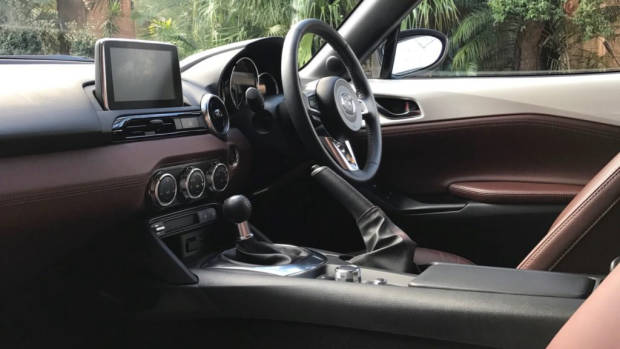
Key specs (as tested)
About Chasing cars
Chasing Cars reviews are 100% independent.
Because we are powered by Budget Direct Insurance, we don’t receive advertising or sales revenue from car manufacturers.
We’re truly independent – giving you Australia’s best car reviews.
The estimate provided does not take into account your personal circumstances but is intended to give a general indication of the cost of insurance, in order to obtain a complete quote, please visit www.budgetdirect.com.au. Estimate includes 15%^ online discount.
^Conditions Apply
Budget Direct Insurance arranged by Auto & General Services Pty Ltd ACN 003 617 909(AGS) AFSL 241 411, for and on behalf of the insurer, Auto & General Insurance Company Limited(ABN 42 111 586 353, AFSL 285 571).Because we don’t know your financial needs, we can’t advise you if this insurance will suit you. You should consider your needs and the Product Disclosure Statement before making a decision to buy insurance. Terms and conditions apply.
Indicative quote based on assumptions including postcode , 40 year old male with no offences, licence suspensions or claims in the last 5 years, a NCD Rating 1 and no younger drivers listed. White car, driven up to 10,000kms a year, unfinanced, with no modifications, factory options and/or non-standard accessories, private use only and garaged at night.
^Online Discounts Terms & Conditions
1. Discounts apply to the premium paid for a new Budget Direct Gold Comprehensive Car Insurance, Third Party Property Only or Third Party Property, Fire & Theft Insurance policy initiated online on or after 29 March 2017. Discounts do not apply to optional Roadside Assistance.
2. Discounts do not apply to any renewal offer of insurance.
3. Discounts only apply to the insurance portion of the premium. Discounts are applied before government charges, taxes, levies and fees, including instalment processing fees (as applicable). The full extent of discounts may therefore be impacted.
4. We reserve the right to change the offer without notice.